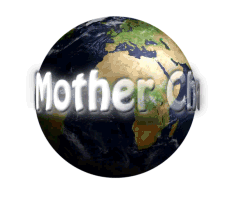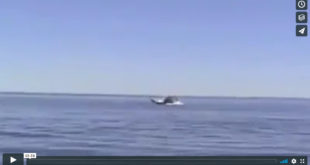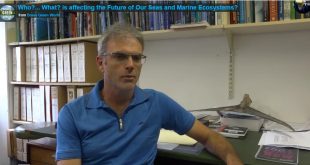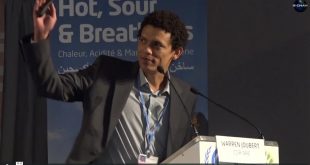In a panel discussion on Avoiding Irreversible Ocean and Polar Thresholds globally, Dr. Carol Turley introduces specialist speakers on the subjects of Oceans, Polar Ice, Sea Rise and Oceanic solutions at COP 22, Marrakech.
Cryosphere on Earth – these are the regions which are covered in ice and snow – either seasonally or all year-round, and Climate Change is happening in the Cryosphere faster and more dramatically than anywhere else on earth! Some ice sheet sectors may already have reached this stage of irreversible melt, but actions taken in coming decades may prevent other portions from reaching this state, as well as reducing the rate of melting. Two different mechanisms account for this “threshold” behavior, first, some ice sheets rest on bedrock below sea level, and that bedrock slopes downwards from the coast inland, this allows warming water to eat away at the ice from below, and it can rapidly become unstable, dumping icebergs into the ocean and raising sea level even before those bergs melt. Second, the effect of increasing temperatures, and hence melting, as the altitude (or elevation) of the ice sheet gets lower, known as the elevation-temperature feedback, affects the Greenland ice sheet and could also affect the Antarctic ice sheet after much warming in the future.
The character of Arctic sea ice already has changed fundamentally with the loss of extremely thick, older (4–5 year) ice that covered most of the Arctic Ocean just a few decades ago; instead today, over half is first-year ice. At current INDCs, with temperatures approaching 3°C above pre-industrial, the Arctic Ocean will behave more like an inland high north lake, losing all ice in summer and regaining a new cover in winter that melts rapidly each spring. On the other hand, unlike the other thresholds, this loss of thicker and older, year-round ice cover is reversible on timescales of decades to a few hundred years should temperatures return to pre-industrial, assuming no major changes in ocean circulation; although some of the impacts arising from this reduction in albedo (reflectivity), such as loss of permafrost, are not.
Permafrost, defined as ground that remains below 0°C for two or more consecutive years, covers nearly 25% of the Northern Hemisphere land area, and when permafrost thaws, carbon emissions to the atmosphere take place in the form of carbon dioxide and methane, which fuels further warming. Permafrost experts issued a consensus estimate of the amount of carbon that will be released during this century, and based on this work, even lower emission levels holding the global mean temperature increase near 1.5°C still means that about 30% of today’s permafrost in the top meter of soil will be lost, resulting in around 50 Gt additional carbon emissions, some of which will occur as methane. Current INDCs, with an increase of 2.7–3.5°C may allow that amount to nearly double by 2100. As warming continues, permafrost will be lost across ever-larger regions, to over 70% of surface permafrost lost by 2100 if global temperature rise exceeds 4.5°C in the highest-emission scenarios, with estimated permafrost carbon emissions between 130–160 Gt.
UNEP, IEA and a host of independent research organizations estimate that current pledges or “INDCs”(“Intended Nationally Determined Contributions”) for Paris will result in global temperatures between 2.7–3.5°C above pre-industrial already by 2100; with final peaks in temperature assumedly higher still, between 3.4–4.2degrees. These estimates have a great deal of uncertainty at the same time, they also assume that all “intended” contributions actually take place. Even so, the resulting peak in global carbon emissions from INDCs will occur well after 2050; and peak atmospheric concentrations likely will reach around 600ppm.
Humanity faces very high risk of crossing certain irreversible thresholds in its Cryosphere regions – setting into motion changes that cannot be stopped or reversed, in most cases short of a new Ice Age. The only way to prevent these dynamics from occurring is to make sure temperatures never rise that high!
Follow other panel speakers on this feature :
- Lars-Otto Reiersen (AMAP) ~ Assessing and Monitoring Arctic Pollution and Climate Issues
- Dr. Hans-Otto Poertner (AWI) – Key Vulnerabilities, Impacts and Risks at 1.5°C warming, socio-economic aspects and addressing impact avoidance and reduced risks.
Links :
http://iccinet.org/wpcontent/uploads/2015/11/ICCI_thresholds_v6b_151203_high_res.pdf (Intl. Cryosphere Climate Initiative – Dr Svante Bodin http://www.arctic-council.org/index.php/en/ (Arctic Council, Norway)
http://www.amap.no/(Arctic Monitoring and Assessment Programme – Lars-Otto Reiersen)
https://www.awi.de/en.html (Alfred-Wegener-Institute~Prof. Hans-Otto Poertner)
 Mother Channel Environmental, climate change news and media.
Mother Channel Environmental, climate change news and media.



